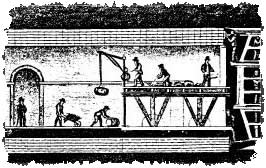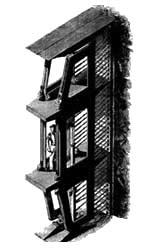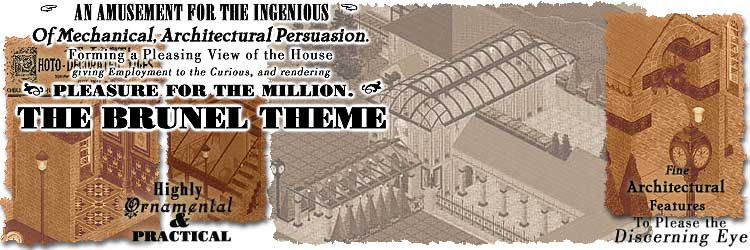
|
| Named
for the great Victorian engineer Isambard Kingdom Brunel, the Brunel
house has been siminised from photographs of industrial Victorian
brick and ironwork. All the furnishing & architectural items you
need to use this lot are either downloadable below in the individual
zips (or in the BigZip at the bottom of the page) or from the original
game. Not all of these architectural items will be found in build
mode; some will be found in buy mode / decorative or buy mode / misc.
|
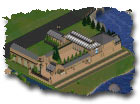 |
|
| Download
the house and everything pictured on this page in one big zip - find this
at the bottom of the page! Zips with the normal winzip
symbol are just the same objects in smaller packs below for those with slower
connections. If you download the big zip, you will NOT need
any of the smaller zips from below unless they are marked with the NEW!
symbol. |
|
|
 |
Isambard
Kingdom Brunel (April 9 1806 - September 15 1859) was a British
engineer who pioneered fast, cheap & reliable mass public
transport with the enthusiasm of a visionary matched by his
ability to convince financiers, inspire his workers and maintain
the high standards that ensured the success of his projects.
|
| The
son of an English mother and noted French engineer Sir Marc
Isambard Brunel, Isambard's life was a hectic sequence of ambitious,
high-risk leading-edge projects involving designing & working
with new technology while dealing with the intricacies of politics,
investors and funding. Throughout his life he never stopped
working on projects which called for complex organisational
ability: working with clients, creating visionary designs, applying
new engineering principles, budgeting, financing, and co-ordinating
& motivating people. |
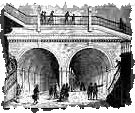 |
Marc
Brunel was a French monarchist whose continuing residence in
revolutionary France had made life there somewhat uncomfortable,
and left at the earliest possible opportunity to become, briefly,
official engineer to the city of New York. During his time there,
he invented a form of block-and-tackle mechanism (combination
of pulleys with a rope or cable, commonly used to augment pulling
force) which is still used to this day. The British Admiralty
were very interested in this mechanism, and Marc moved to England.
Settling in London, he became a consultant engineer to the Royal
Navy. |
| Because
of this, Isambard had a French and English education. He was
sent to France to be educated at the College of Caen in Normandy
and the Lycée Henri-Quatre in Paris. His education included
studying mathematics and an apprenticeship with M. Breguet,
a precision-instrument maker. Further practical experience came
from working in the family engineering office and at the Maudsley
engineering works where in 1829 the famous engineer, James Nasmyth
(of the Bridgewater Foundry and 1839 steam hammer fame) also
trained. Isambard rose to prominence when, aged 20, he was appointed
as the resident engineer of the Thames foot tunnel, his father's
greatest achievement. |
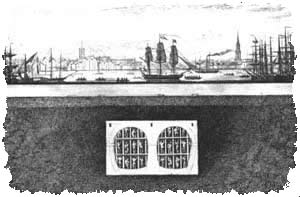 |
|
|
|
|
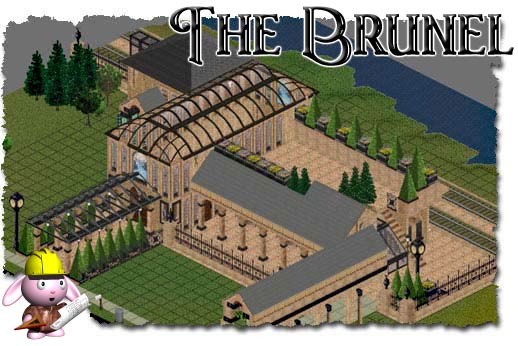 |
 The
Brunel House - Lot 8 The
Brunel House - Lot 8
PLEASE
NOTE: This zip does not contain any objects, walls or floors. You
will need to download, unzip and install all the object, wall &
floor zips from below before playing this house, otherwise you will
get the dreaded "missing objects" box and the house will
be incomplete.
There is no shopping
list for this house - all the pieces it is furnished with are found
below or in the original game. |
|
|
|
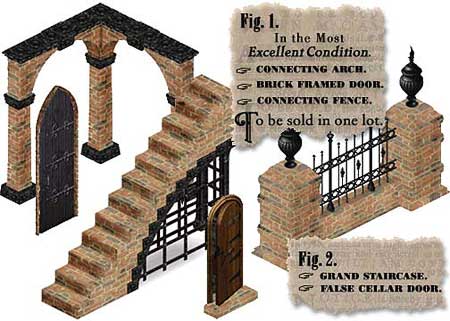 |
|
 Fig.1: Arch, door, fence
Fig.1: Arch, door, fence
Door
cloned using the wonderful no-gap base by Aenigma
Sim
|
|
|
|
 Fig.2: Staircase, "Cellar" Door
Fig.2: Staircase, "Cellar" Door
The
"cellar" door is actually a picture and is backless.
Your sims won't trip over the step either.
|
|
|
|
|
| Adjoining
the Engine House is the original brick shaft. This shaft
was Isambards' first solo project. This was the first
part of the works and was itself one of the most innovative
aspects. The circular shaft was built on the land surface
course by course while the miners undermined the foundations,
which allowed the brick & iron lining to gradually
sink into the ground in a controlled manner. |
 |
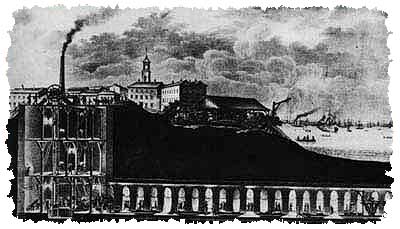 |
The
tunnel was opened as a pedestrian route in 1843, but was
sold to a railway company in 1865. It is still used by
the London Underground today, and passengers travelling
between Wapping & Rotherhithe will have the pleasure
of passing through this historic piece of engineering.
The Engine House houses a museum dedicated to the life
and work of Marc & Isambard Brunel. |
|
|
|
|
|
|
Fig.3: 
Four
brick framed windows
|
|
|
|
Fig.4: 
Connectable
Railway Rug using the image from the Railway Track Rug at
Sim Gypsy,
with many thanks to Zzziana, "safety" step (based
on the cloneable one tile rug at Sim Freaks), wall and street
lamp recoloured from originals at Secret Sims, and animated
furnace altered from an original by Simzalabim - all with
many thanks to their original creators for allowing their
objects to be freely cloneable while their sites were up.
|
|
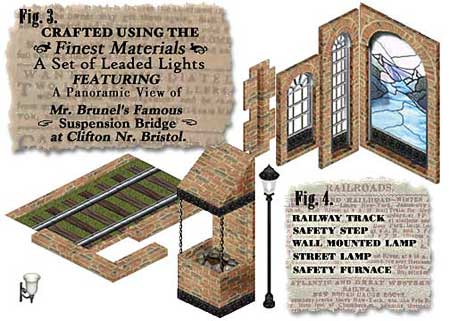 |
|
|
|
| Isambard
was a work-a-holic who would readily work a 18 hour day
and sleep in his office. Holidays were usually forced
on him by his doctor. His honeymoon consisted of three
days in Capel Curig in North Wales - with a visit to the
Liverpool-Manchester railway opening rolled in, naturally.
We can only presume that the new Mrs. Brunel also had
a fondness for railway engineering. |
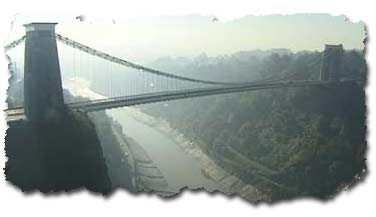 |
Although
Isambard was an industrial visionary, he also possessed
an artists eye for the landscape, and when planning
his works his designs always complemented the surroundings
they were in.
The
Clifton Suspension Bridge project over the Avon Gorge
in Bristol (pictured left, as it stands today) demonstrates
this as well as testing all the other skills & qualities
that Brunel had. It was built at a time of intense competition
between ports to retain business and capture substantial
growth in trade and economic prosperity. Brunel submitted
his radically new design for the bridge (1830) in a
competition with Thomas Telford and others. He finally
won the design competition - after much debating, as
always.
|
| In
1836 an iron bar 305 metres long was hauled across the
Avon Gorge, and a basket to transport men and materials
was slung from it. Brunel himself made the first crossing
but the basket stuck at the lowest point, 60 metres above
the river. Brunel climbed out of the basket, up the rope
and released the cable from the jammed pulley. Trips were
later made in the basket for pleasure. Yes, you read that
last word right. Sure makes today's "white knuckle"
rides tame by comparison. |
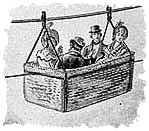 |
|
|
|
|
|
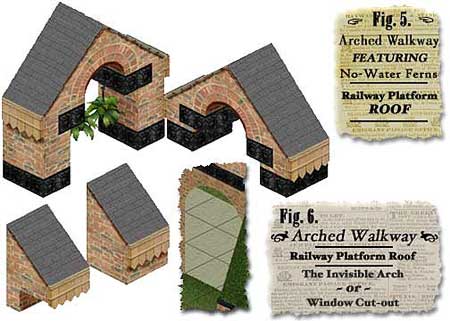 |
|
 Fig.5: Arch kit pt. 1
Fig.5: Arch kit pt. 1
 Fig.6: Arch kit pt. 2
Fig.6: Arch kit pt. 2
|
| |
| These look
best when used with the transparent floor from Caro's
Sim Kagen. And you never need bother watering the ferns
either :o) Thanks to the awesome talent of
Cooptwin The Amazing And Magnificent, the three-tiled arch gable
pieces are droppable - you won't see them when played with walls
cutaway or down and will remain in place when the house is sold.
See more of Cooptwin's work at Another
#%*& Sim Site |
|
|
|
|
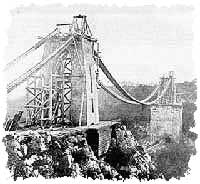 |
By
1843 the two towers were completed but funds were exhausted.
To save money, the committee reduced the height of the
towers and didn't go ahead with the planned sphinxes
for the tops or the cast iron cladding around them designed
to tell the story of the bridge. By 1853 the time span
for completion allotted by Parliament expired. The committee
sold the ironwork, machinery and equipment to pay the
contractors, and much of the material was used on Brunel's
Royal Albert Bridge linking Devon and Cornwall at Plymouth.
Brunel
died without ever seeing the completion of his bridge.
Ironically, his early death inspired the completion
of the bridge, as the Institute of Civil Engineers decided
to finish the bridge as a memorial to him.
|
| By
coincidence the Hungerford Suspension footbridge in London
also designed by Brunel, was about to be demolished to
build a railway bridge and the chains were bought for
£5,000. A new bridge company was formed in May 1860
and a new Act of Parliament confirmed that the Clifton
Suspension Bridge would be completed under the supervision
of Sir John Hawkshaw and W H Barlow. Happily for today's
road traffic these engineers decided to widen the roadway
from 7 metres to 9 metres. |
|
The
bridge retains many elements from its original Egyptian
style design (which was extremely popular at the time)
but as above, the planned sphinxes were sadly omitted
from the completed bridge - you can see where they should
have sat from the engraving reproduced on the right.
One can be fairly sure that were the bridge built during
Brunel's lifetime, he would have ensured that the money
was found for them from somewhere.
The
bridge is to this day in constant heavy daily use and
is still a spectacular sight from both above on the
cliffs and below by boat.
|
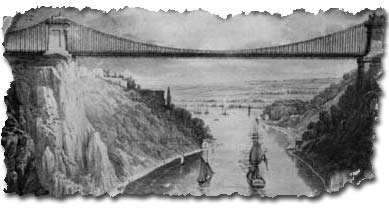 |
|
|
|
|
|
Fig.7: Posters

A
selection of one-tile reversible railway posters - the larger ones
are a little wider at each side than the one tile, so they sit in
a different position than a two-tiled painting would.
Reversible
means that from whatever angle you are looking at them from, the
words are the right way round!
The
portrait-shaped ones and the three decorative wall recesses were
cloned from an original base by PkTechGirl at the lovely Juniper
Sun
|
 |
|
|
|
|
While
Brunel was still in Bristol, he became aware that the
civic authorities saw the need for a railway link to
London. The Liverpool & Manchester Railway, successfully
connected one of England's biggest ports with its largest
textile manufacturer. Incidentally, this is generally
regarded as the first true railway not because it was
the earliest (it wasn't) but because it was the first
to carry both passengers and freight solely by the use
of steam powered engine.
Liverpool was only one of England's great Atlantic ports,
and the merchants of Bristol feared huge loss of business
unless they could obtain the benefits of this new technology
as well. As there was no nearby manufacturing centre
comparable with Manchester, they ambitiously set their
sights on linking to London, which would mean building
a railway well over four times as long as the Liverpool
& Manchester.
|
 |
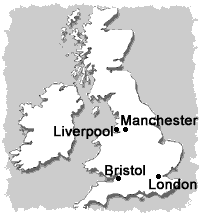 |
Despite
the apparent failure of the Clifton Suspension Bridge
project, in March 1833, Brunel was appointed by the
promoters of the projected Bristol to London railway
to complete a preliminary survey of the route by May.
To do this, he designed what he called his "Flying
Hearse" - a streamlined carriage which doubled
as office and bedroom - and home for a humidor of 50
cigars. Six months later, the final plans were completed
and in March 1834 the findings went to the customary
parliamentary committee for scrutiny.
Railway
location was controversial, since private landowners
as well as towns had to be dealt with. Quite frankly,
the landed gentry did not want a messy, noisy railway
anywhere near them. The Duke of Wellington (of Waterloo
fame) was certainly against it & is famously reported
to have said : "...
it will only encourage the lower classes to move about."
Brunel
and his team had their work cut out for them just in
persuading the Parliamentary committee to let the work
commence.
|
|
|
|
|
|
 |
 Fig.8:
Fig.8:
The "basement"
is actually a rug, and if you don't put a fence around it, the sims
will happily walk all over it. Alternatively,
it goes very nicely underneath an exising staircase.
"Glass
roof" recoloured with kind permission from Koromo, at Persimmon
Grove. To get the square frame effect I used two roofs
placed on top of each other but one rotated to give the glass a
frame on all four sides. The fence is based on the cloneable one-tiled
rug from Sim Freaks & modified from an original by STP Carly
at the Sims Tattoo Parlour. Wall buttress base object is by Marina
at Marina's
Sims.
|
|
|
|
| After
hearing Brunel speaking to the committee in 1835, an eye-witness
wrote: "He was rapid in thought, clear in language
and never said too much or lost his presence of mind.
I do not remember ever having enjoyed so great an intellectual
treat as that of listening to Brunel's examination."
Bear in mind that the cross-examination had gone on for
eleven days to a mostly hostile audience. He won his case. |
 |
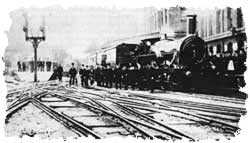 |
Isambard
Brunel was therefore appointed engineer of what was to
become the Great Western Railway, one of the wonders of
Victorian Britain. The Great Western contained a series
of impressive achievements - viaducts, stations, and tunnels
- that ignited the imagination of the technically minded
Britons of the age, and Brunel soon became one of the
most famous men in Britain on the back of this interest,
also helping to establish him as one of the world's leading
engineers. He eventually engineered over 1,200 miles of
railway, including lines in Ireland, Italy and Bengal.
His great civil engineering works on the line between
London and Bristol are still used today by frequent high-speed
trains. |
| Notable
structures on the original Great Western route from Bristol
to London include the viaducts at Hanwell and Chippenham,
the Maidenhead Bridge, the Box Tunnel and the Bristol
Temple Meads Station. There is an interesting anecdote
which states that the Box Tunnel is placed such that the
sun shines all the way through it on Brunel's birthday.
This would be wonderful if it was true - but opinion in
the absence of authenticated written instruction to the
construction team as always in such things is divided.
Nevertheless, there is an interesting discussion about
it here.
However, it is said that Brunel walked every mile of the
railway while he was appointed chief engineer, so the
possibility is there, if rather tenuous. |
 |
|
|
|
|
|
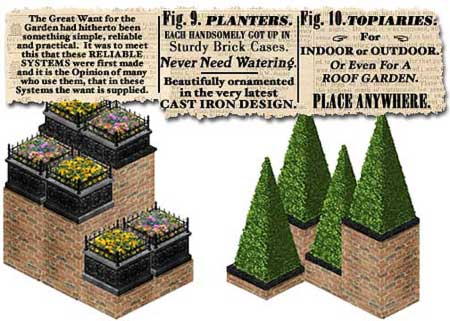 |
|
 Fig.9: Planters
Fig.9: Planters
 Fig.10: Topiaries
Fig.10: Topiaries
|
| |
| Three
sizes of topiaries and planters. None of these ever need watering
and can be placed indoors or on a second floor to make a secluded
roof garden. Thanks once again to Cooptwin,
the medium and high topiary & planter pieces are droppable
- you won't see them when played with walls cutaway or down.
See more of Cooptwin's work at Another
#%*& Sim Site
|
|
|
|
|
| As
we learned above, Brunel was also keen to make his
structures aesthetically pleasing as well as functional,
and there is no finer demonstration of this than
in the wrought iron arch framework and other details
of Paddington Railway Station, London. Even the
patterned holes stamped out of the arches had a
function - to hang cleaning gantries from. Cleaning
must have been a dangerous job to have, dangling
high above all those steam trains & stone platforms,
yet it was done very regularly - with no recorded
accidents. |
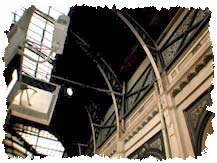 |
Paddington
Station was built as the London terminal of
the Great Western Railway, and was opened
in 1854. It was Brunel's dream to integrate
the travelling experience for the passenger
totally and conceived of having a grand hotel
at either end of his railway lines. |
|
|
The Great Western Hotel (now restored to a luxurious
1930s splendour by the Hilton Group) was the work
of architect P.C. Hardwick. It was added in 1868-74,
and is a large white building with two towers and
a central pediment with classical figures facing
Praed Street, some with features representing exotic
lands, world travel & engineering. |
|
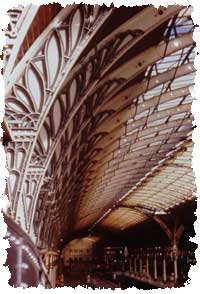 |
| The
organisation "English Heritage" recently stated
that Paddington Station is an internationally important
part of Britain’s industrial architectural heritage,
and is therefore soon to be nominated for World Heritage
Site status. |
|
|
|
|
|
|
Two
sectional Glass Roofing Kits - one for the first storey and
one for the SECOND storey. Fig.11: 
|
|
By Koromo
of Persimmon Grove, this set of glass roof pieces is for a
second floor.
To achieve
this effect on any other house, you will need to build your
second floor with a one-tile gap. Use one of the two
different mock window pieces in the gap. When you place the
roof pieces (you will have to rotate them to fit together)
you will note that they are much higher up than the first-floor
pieces. Your sims will happily walk about underneath all the
pieces, and you can place furniture without any problems.
|
Fig.
12: 
|
|
This
is a first floor roof kit, which goes on the second floor
on the transparent tile. The glass end piece & roof
were recoloured once again with kind permission from Koromo,
at Persimmon Grove. This zip also includes the transparent
floor tile for which I am very grateful to Caro of Caro's
Sim Kagen for permission to include it.
|
|
 |
|
|
|
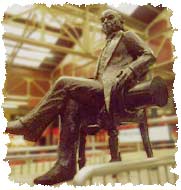 |
There
are three statues of note within Paddington Station
- a seated statue of Isambard Brunel by John Doubleday
at the side entrance to platform 1 (the picture was
taken before his move there); a combined World War I
& II Memorial by Charles Sargeant Jagger - a large,
solid-looking figure of a cloaked soldier in full battle
gear halfway down platform 1, but perhaps the most photographed
statue of them all is found in the inner concourse area.
This
is of Paddington
Bear, based on Michael Bond's whimsical series of
11 books first published in 1958 based around the adventures
of a small bear newly arrived from "Darkest Peru"
and is a magnet for tourists & children of all ages.
|
| The
Brown family, of 32 Windsor Gardens, first meet
Paddington Bear on a railway platform in London.
He is sitting all alone on a battered suitcase,
behind a pile of mail bags, close to the lost property
office. Although he will later acquire a blue duffle-coat
that is a little too big for him and even later
an occasional pair of wellingtons, when the Browns
first meet him he is wearing nothing but an odd-looking
hat (later discovered to be home to a packet of
marmalade sandwiches) and a sign around his neck
that reads, "Please look after this bear. Thank
you." |
| |
| And
that is just what the Browns do, naming him after
his finding-place, completely unaware that home
will never be the same once Paddington becomes a
member of the family. For an earnest, gentle, and
well-meaning bear, poor Paddington has an absolute
talent for getting into trouble. "Things happen
to me. I'm that sort of bear". The Paddington
books have sold more than thirty million copies
worldwide and have been translated into thirty languages. |
|
 |
|
|
|
|
|
 |
|
 Fig.13: Three Bookcases
Fig.13: Three Bookcases
One empty,
one with normal sim books, and one with vintage oversized
bound railway timetables. These fit snug against a wall to
appear as if they are recessed and are backless as the z's
would have been impossible so close to the wall.
|
| |
|
 Fig.14: Trees
Fig.14: Trees
Outdoor
/ Indoor / Second floor trees with & without lights. The
lighted ones will require the Party Lights fence download
from the official site. Find it under Build mode
/ Walls. The non-lighted trees are droppable.
Idea
credit for decorative steps to Simzalabim although these steps
are solid, and the sims cannot walk on or through the steps
so they should not be placed where access is needed.
|
|
|
|
|
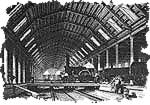 |
Even
before the Great Western Railway was opened, Isambard
Brunel was moving on to his next project - transatlantic
shipping. While involved in the Bristol - London rail
link, his plans started to take on a far grander scale.
His dream was to extend a high-speed & reliable public
transportation connection from England to New York, and
he now started to set his sights on building the ships
for the sea link. Brunel put the suggestion to the GWR
company directors in 1835 that the Great Western Railway
should extend its London-Bristol service to New York via
a "steamboat." |
| Although
a regular packet service between Europe and North America
had been in place since 1816, it was all by sail, not
steam. Though taken up by the company, the idea was considered
sheer folly, as it was widely believed that the power
- and hence its fuel, coal - required to drive a steamship
varied in direct proportion to the size of the hull. It
was Brunel who devised the elegant formula demonstrating
that though a ship's capacity increases as the cube of
the hull's dimensions, the power required to drive it
increases only as the square of the dimensions. |
 |
|
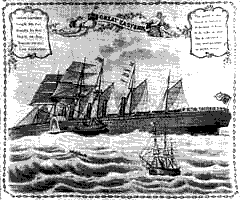
|
As
late as the 1890s, sailing clipper ships were still
the preferred method of long-distance travel. There
were several reasons for this. The wind, of course,
is free and, while the navies of the world could and
did discount the cost of coal, hard-headed commercial
men needed more convincing - especially considering
the notorious unreliability of early steam engines and
their restricted range. At first, just as sail had been
used as an addition to oared galleys, steam was used
as an adjunct to sail. A ship's engine would be fired
up only when the wind dropped - an approach which combined
economy with the reliability of sail and the ability
to keep moving in any conditions.
Brunel
was to change all of this. Each of his three ships represented
a major step forward in naval architecture. His Great
Western of 1838 was the first steamer designed to cross
the Atlantic, while in 1845 he constructed the Great
Britain, the first propeller-driven ocean-going ship.
|
|
|
|
|
|
 |
|
 Fig.15: Five Gable Pieces
Fig.15: Five Gable Pieces
The largest
roof segment comes with and without mock windows. You can
place these in any way you like to give the effect of a multi-storey
building.
|
| |
|
Gable
roof idea & shape by Ophelia at Ophelia's
Little Page About The Sims although I have modified mine
somewhat so that they have all four views and can be placed
against walls at any rotation - and now with vastly improved
Zs so they DO NOT BLEED through walls anymore.
And thanks to Cooptwin, they are droppable so that when you
play the game in walls down or cutaway modes, they become
invisible!
The clock
is actually a garden lamp.
|
|
|
|
|
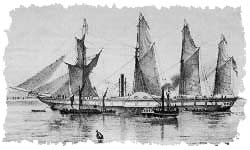 |
The
PS Great Western was a wooden paddle steamer with iron
trusses. Launched from Bristol, she completed 45 Atlantic
voyages to New York for her original owners, The Great
Western Steamship Company, before being sold to The Royal
Mail Steam Packet Company. Considerably larger than any
vessel built in Europe, her engines were the most powerful
yet built. She was designed to carry 148 passengers, and
boasted a main passenger saloon 75 feet long by 34 feet
at its widest, again a superlative achievement. The first
trip to New York took just 15 days, and 14 days to return.
This was a great success; a one way trip under sail would
take more than a month. The ship was broken up for scrap
in 1856-57 after a long, varied & hard working career. |
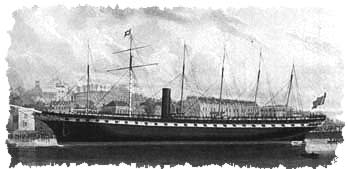 |
The
SS Great Britain lies now in Bristol's historic harbour
- today a tourist and recreation attraction salvaged
from rusty oblivion, but in its day was by far the largest
ship in the world - over 100 feet longer than her rivals.
The Great Britain was made of iron and also built in
Bristol, 322 feet in length. The ship was launched in
1843 and was the first screw driven iron ship to cross
the Atlantic.
For
more information on the ship and its restoration, visit
http://www.ssgreatbritain.org/
|
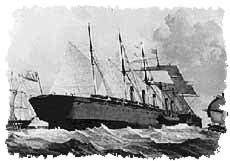 |
His
greatest technical triumph was his third ship - the Great
Eastern of 1858, which reverted to paddlewheels and had
six sail masts and five funnels. Big enough to carry enough
fuel to get to Australia without refuelling, in addition
it would carry 4,000 passengers or up to 10,000 troops.
She was and remained the largest ship afloat until the
end of the century - and at 10,200 tons, was the only
ship large enough to carry and lay the first Transatlantic
cable, comprising of 5,000 tons of telegraphic cable to
be laid on the ocean floor from Ireland to Newfoundland.
However, the stresses and strains of this project took
a great toll on Brunel. |
|
|
|
|
|
|

|
 Fig.16: Glass Conservatory
Fig.16: Glass Conservatory |
| |
|
You can
make an ultra-modern cube by just using the full length window,
Caro's glass floor and the lower roof piece, or as it is in
the Brunel house, with the slanted glass roof, small false
window & medium high roof piece. I have also used parts
of this kit to give a high glass roof to the "basement"
rug in the Brunel house.
The false
window also is very effective as a room divider.
With many
grateful thanks to Iona for the original idea of cubed windows,
and Koromo for the use of the droppable one tiled rug segment.
|
|
|
|
|
|
With
the Great Eastern project, Brunel had produced something
that was at the leading edge of the available technologies
of the time. The vision and the design concepts were
always pushing ahead, but much that was needed was way
too ahead of their time - the necessary component materials
were not yet available or possible to make non-degrading
flexible material to replace leather fan belting, for
example.
For
this project, he was required by the Great Eastern Company
to work with a collaborator - the marine engineer and
shipbuilder John Scott Russell (pictured far right,
with Brunel second from the left), who was awarded the
contract to build the vessel in his own shipyards on
the Isle of Dogs in the Thames, London. However, Brunel
soon felt he was let down by what he saw as Russell's
poor management practices. Among other things, Russell
was very low in his estimates and money was soon a problem.
|
 |
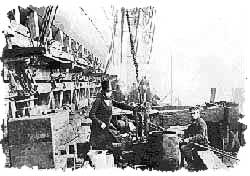 |
The
Great Eastern project hit major financial problems as
the launch date approached and Brunel blamed Russell for
misuse of funds. Russell seemed to have a better relationship
with the press who poured scorn on Brunel. The project
went broke, and much of what Brunel needed to complete
the project himself was in Russell's hands and a situation
of litigation with reputations at stake soon emerged,
while Brunel kept trying desperately to regain control
of his project. |
|
The
first attempt to launch the Great Eastern on November
3, 1857 was widely publicized and tickets were sold
to the public in an attempt to raise some much needed
capital.
This
came as a surprise to Brunel, who had anticipated a
quiet and businesslike launch and instead found the
shipyard filled with thousands of spectators waiting
to see the largest object ever moved by man.
The
launch date could not be moved, and the decision to
go ahead was reluctantly made.
This
was a great mistake.
|
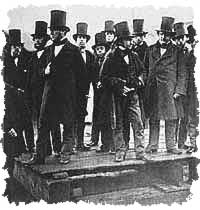 |
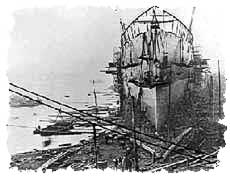 |
The
launch attempt was both a public relations disaster
and a human tragedy. The resulting circus like atmosphere
of the revelling crowds led to difficulties in communications.
Chains snapped on capstans leading to the death of one
worker and injury to a half dozen others.
Although
Brunel himself never made this claim either in private
or in public, there were many rumours of sabotage made
by rivals wanting Brunel and his project out of the
way. Whatever the truth or lack thereof, the ship now
had to be virtually pushed into the Thames and despite
almost constant attempts needing hydraulic rams, she
did not take the water until January 31, 1858. Fitting
out lasted until September 1859.
|
|
|
|
|
|
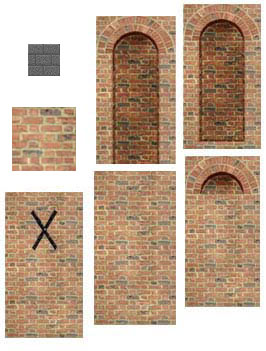 |
|
 Five mix 'n' match wall treatments, floor tile, roof tile
Five mix 'n' match wall treatments, floor tile, roof tile
|
| This one
zip contains all the brick walls, the floor and the roof. Unzip
to a temporary storage folder, and move the files ending in
: |
-
.wll
to C:\Program Files\Maxis\The Sims\Gamedata\Walls
-
.flr
to C:\Program Files\Maxis\The Sims\Gamedata\Floors and
-
.bmp
to C:\Program Files\Maxis\The Sims\Gamedata\Roofs
|
|
 Six interior wall treatments with matching floors (pictured
below).
Six interior wall treatments with matching floors (pictured
below).
|
| Victorian
wallcoverings are a wonderful thing - they basically took whatever
was available and used it. So it would not be unusual to see
tooled leather, ceramic, majolica tiles or heavily varnished
lincrusta (an embossed paper stiffened with plaster-of-paris)
used below the dado (chair) rail, with silk, satin & other
fabrics or of course printed paper above the rail. |
|
|

|
The lower part
of the wallcovering had to be the most hardwearing to accommodate
wear and tear from passing ladies' bustles, crinolines and other
whale-bone accessories as well as furniture. Also, because many
roads were still unpaved, in the winter months removing splashes
of sticky, foul smelling mud was a huge problem in the house.
The strangest
thing for us today to understand in our world of stripped pine is
that bare wood was never seen in a gentrified house. That was seen
to be for the poorest families who could not afford to use the latest
lead-based paints or dark coloured woodstains / varnishes to cover
up the wood. But leather was sometimes tooled to resemble bare wood
panelling and used below the dado rail instead.
|
|
|
|
| Isambard's
herculean personal interventions secured the launch
of the Great Eastern into the Thames, but because
of failing health, he was again forced to oversee
Russell's work. Soon after a difficult and troublesome
launch, and moments after possibly the most famous
pictures of Brunel standing dwarfed by the launching
chains of the SS Great Eastern were taken, he collapsed,
having had a stroke. He was taken home but died
soon afterwards and was buried in Kensal Rise Cemetery
- not far from Paddington.
During
trials on the Great Eastern on September 5 1859
- just a few days before Brunel's death - there
was a disastrous explosion on board, and repairs
forced the postponement of Great Eastern's maiden
transatlantic voyage until June 1860. It is not
known whether Brunel got to hear about this or
not.
Sadly,
due to the many problems with the launching &
trials, and the fact that Brunel was there no
longer to champion his vessel, the Great Eastern
was not a commercial success, and never carried
a full complement of passengers.
|
 |
At
the end of its days, in August 1888, having
been used for many purposes but its original,
including a fairground and advertising hoarding
(left), the fate of the Great Eastern was
sealed when it was sold for scrap. |
|
|
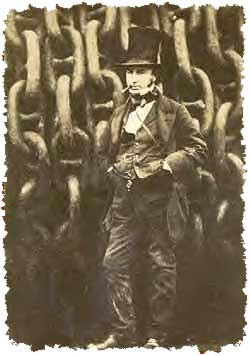 |
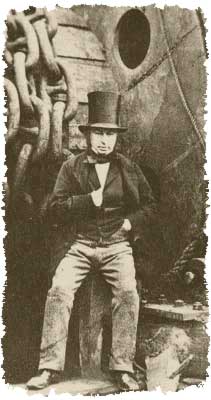 |
Deconstruction
work started on 1 January 1889, on the banks of the
Mersey, near Liverpool, where the great ship had lain
rusting for some time.
Taking
the iron hull apart was a matter of brute force, and
over the next two years men chiselled, levered and hammered
its plates apart until there was nothing left. The destruction
of the ship gave birth to the macabre legend that two
skeletons, the remains of a riveter and his boy apprentice,
were found inside the sealed double bottomed hull. At
the time it was thought that perhaps it had been the
souls of these poor unfortunates that had cursed the
great ship with so much bad luck.
This
one engineer in 19th century Britain transformed the
landscape and the lives of everyday people by creating
and raising what we today would call "venture capital"
to build the ideas, devices and systems of new technology
- bridges, railways, tunnels, viaducts and ships - that
transformed peoples lives and the world as a whole.
Inland journeys of hours rather than days became normal.
Journies formerly beyond the imagination or reach of
the average person were now possible and affordable.
The crossing of the Atlantic became safe with the availability
of iron-clad, steam driven, screw propelled vessels.
Some
of Brunel's greatest achievements involved the use &
development of industrial strength brick, decorative
cast iron, viaducts and bridges in the dawning of the
age of mass transportation. Many of his engineering
principles are still used to this day - some of which
have never been bettered.
Many of his structures are in daily use today - and
undergoing far heavier use than even he could have anticipated.
|
|
|
|
|
|
| The
house and all the objects above can be downloaded in this one BIGZIP
: |
 This
is just a normal zip file with all 104 items of the Brunel Theme inside
one large zip. This
is just a normal zip file with all 104 items of the Brunel Theme inside
one large zip. |
|
|
This one zip contains
the house, all the objects, the walls, the floor and the roof - everything
pictured above that does not have the NEW! symbol next to it. Unzip to
a temporary storage folder, and you must move the files accordingly as
below:
|
- House08.iff
to C:\Program Files\Maxis\The Sims\UserData\Houses (for the original
"The Sims") or C:\Program Files\Maxis\The Sims\UserDataXX\Houses
- where XX is the number of the neighborhood. For example, if you
want it in Neighborhood 3, it goes to: C:\Program Files\Maxis\The
Sims\UserData3\Houses\House08.iff
- Files ending
in .wll to C:\Program Files\Maxis\The Sims\GameData\Walls
- Files ending
in .flr to C:\Program Files\Maxis\The Sims\GameData\Floors
- Files ending
in .bmp to C:\Program Files\Maxis\The Sims\GameData\Roofs
- All other
files ending in .iff to C:\Program Files\Maxis\The Sims\GameData\UserObjects
If you would like
to redesign or recolor objects from the Brunel set, please provide credit
on your site and in the object description with a link back to us. Most
recolours here are from base items from sites participating in the Recolourers
Resource Project, but where I have had specific permission for an item
to be cloned for this set, you will need to ask the same permissions from
the original designer - these are as follows:
|
- Items from Secret
Sims can no longer be cloned and modified or recoloured.
All links to the original
site where I have made the recolour from are given. See notes on home
page.
|
 |
Without
actually advertising the books themselves, I would still like to
mention just some of the books I used in researching this potted
history of I.K. Brunel. I
have always been fascinated by his works, and now especially I live
very close to some of them I have come to appreciate just how much
this one remarkable man changed global society in ways that last
today and for much time to come. Redoing this page gave me the excuse
to go down to my local library with notebook & pencil, and act
like a student once again.
I
also had a complete riot in trying to emulate some of the flowery
advertising styles and language of the era in presenting my downloads.
Inspiration for this largely came from finding this instruction
sheet for a cardboard 3D model of the Thames Tunnel - which seems
to imply that not only would your intelligence be raised considerably
by the purchase and construction of this model, but that you would
become an engineer on par with Brunel himself. Victorian newspapers
from the archives at my local library were also a rich source of
phrasing and inspiration.
The
pictures I have used were either used with permissions, scannable
for non-profit use, acquired in a huge image licence I recently
bought or are public domain and permission free. The text was rewritten
myself from extensive notes I made from the following books:
-
Brunel's
Ships : Denis Griffiths, Andrew Lambert, Fred M. Walker, Susan
Baylis.
-
The Great Iron Ship : James Dugan
-
John Scott Russell : George S Emmerson
-
Ships
of the World : An Historical Encyclopedia.
-
Isambard
Kingdom Brunel : R.T.C. Rolt
-
I
also used the online encyclopedia "Wikipedia"
|
|






